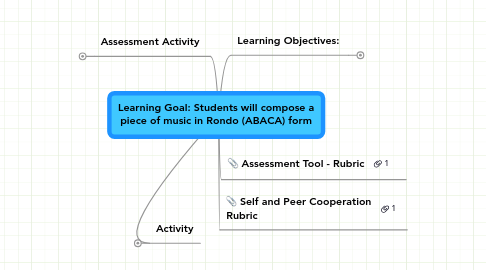Learning Goal: Students will compose a piece of music in Rondo (ABACA) form
Barbara Vinalにより

1. Assessment Activity
1.1. Standard 4: Student composition has 3 different sections (A,B and C) both rhythmically and tonally.
1.2. Standard 5: Final work is submitted in Finale (or some other readable notation format) as a complete composition.
1.3. Standard 5: Composition contains at least 5 of the following elements – treble clef, double bar line, dynamics, 4 measures in each section, correct number of beats in each measure, time signature, and ends on the note ‘C’.
1.4. Standard 7: Completes the peer cooperation rubric for self and others; accepted a role and completed assigned tasks. Adds to Wiki at least twice each week.
2. Activity
2.1. Students will randomly choose A, B or C.
2.2. Each group of three students will compose 4 measures of music using a software notation program such as Finale
2.3. Sections will be put together in Rondo form (ABACA pattern) to create a complete piece of music.
2.4. Students will provide ongoing communication via the Wiki as evidence of team cooperation.
2.5. Student team will submit final composition.
2.6. Students will submit a self and peer cooperation rubric upon completion of assignment.
3. Self and Peer Cooperation Rubric
4. Learning Objectives:
4.1. National Standard for Music Education 4: Composing and arranging music within specified guidelies
4.2. National Standard for Music Education 5: Reading and notating music.
4.3. National Standard for Music Education 7: Evaluating music and music performances
5. Assessment Tool - Rubric


